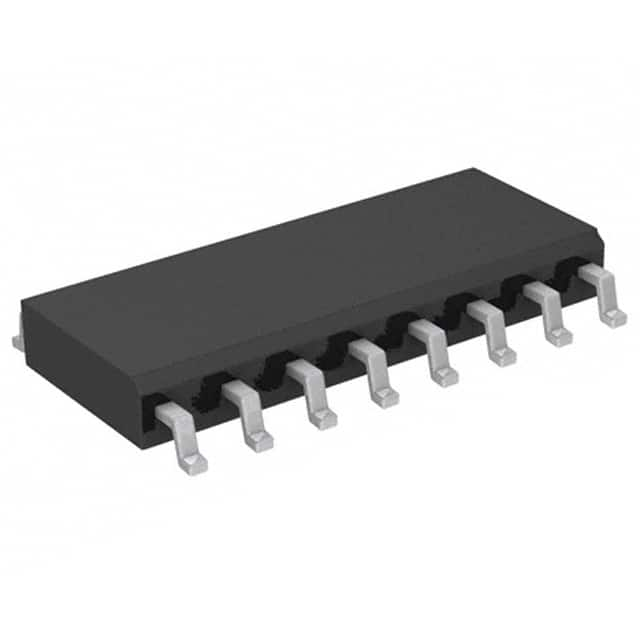Lihat spesifikasi untuk detail produk.

MC74ACT138D
Product Overview
Category
MC74ACT138D belongs to the category of integrated circuits (ICs).
Use
This IC is commonly used as a 3-to-8 line decoder/demultiplexer.
Characteristics
- High-speed operation
- Low power consumption
- TTL compatibility
- Wide operating voltage range
- Schmitt trigger inputs for noise immunity
Package
MC74ACT138D is available in a standard 16-pin dual in-line package (DIP).
Essence
The essence of MC74ACT138D lies in its ability to decode a three-bit binary input and activate one of the eight output lines based on the input combination.
Packaging/Quantity
MC74ACT138D is typically sold in reels or tubes, with each reel/tube containing a specific quantity of ICs. The exact packaging and quantity may vary depending on the supplier.
Specifications
- Supply Voltage: 2V to 6V
- Input Voltage: 0V to VCC
- Output Voltage: 0V to VCC
- Operating Temperature Range: -40°C to +85°C
- Maximum Propagation Delay: 10 ns
- Maximum Quiescent Current: 4 mA
Detailed Pin Configuration
- GND (Ground)
- A0 (Input A0)
- A1 (Input A1)
- A2 (Input A2)
- E1 (Enable Input 1)
- E2 (Enable Input 2)
- E3 (Enable Input 3)
- Y0 (Output Y0)
- Y1 (Output Y1)
- Y2 (Output Y2)
- Y3 (Output Y3)
- Y4 (Output Y4)
- Y5 (Output Y5)
- Y6 (Output Y6)
- Y7 (Output Y7)
- VCC (Supply Voltage)
Functional Features
- Decodes a 3-bit binary input to activate one of the eight output lines.
- Enables cascading multiple MC74ACT138D ICs for larger decoding applications.
- Schmitt trigger inputs provide noise immunity and improve signal integrity.
Advantages and Disadvantages
Advantages
- High-speed operation allows for quick decoding.
- Low power consumption makes it suitable for battery-powered devices.
- Wide operating voltage range provides flexibility in various applications.
- TTL compatibility ensures easy integration with other logic circuits.
Disadvantages
- Limited to 3-bit decoding, not suitable for higher bit applications.
- Requires external enable signals for proper functioning.
Working Principles
MC74ACT138D works based on the principle of binary decoding. The three input pins (A0, A1, A2) accept a 3-bit binary code, which is then decoded to activate one of the eight output pins (Y0-Y7). The enable pins (E1, E2, E3) control the activation of the outputs based on the input combination.
Detailed Application Field Plans
MC74ACT138D finds applications in various fields, including: 1. Address decoding in microcontrollers and microprocessors. 2. Memory selection in digital systems. 3. Data routing and multiplexing in communication systems. 4. Control signal generation in industrial automation. 5. Logic circuit design and prototyping.
Detailed and Complete Alternative Models
Some alternative models to MC74ACT138D include: 1. SN74LS138N by Texas Instruments 2. CD74HC138E by Texas Instruments 3. 74HCT138 by NXP Semiconductors 4. DM74LS138N by Fairchild Semiconductor 5. 74F138 by ON Semiconductor
These alternative models offer similar functionality and can be used as substitutes for MC74ACT138D in various applications.
Word count: 529 words
Sebutkan 10 pertanyaan dan jawaban umum terkait penerapan MC74ACT138D dalam solusi teknis
Sure! Here are 10 common questions and answers related to the application of MC74ACT138D in technical solutions:
Q: What is MC74ACT138D? A: MC74ACT138D is a 3-to-8 line decoder/demultiplexer integrated circuit (IC) commonly used in digital electronics.
Q: What is the purpose of MC74ACT138D? A: The purpose of MC74ACT138D is to decode a binary input and activate one of the eight output lines based on the input value.
Q: What is the voltage range supported by MC74ACT138D? A: MC74ACT138D supports a voltage range of 2.0V to 6.0V, making it compatible with various digital systems.
Q: How many inputs does MC74ACT138D have? A: MC74ACT138D has three binary inputs (A0, A1, and A2) that determine which output line will be activated.
Q: How many output lines does MC74ACT138D have? A: MC74ACT138D has eight output lines (Y0-Y7), each corresponding to a specific combination of the input values.
Q: Can MC74ACT138D be cascaded to increase the number of output lines? A: Yes, MC74ACT138D can be cascaded with other decoders to increase the number of output lines in a system.
Q: What is the maximum output current of MC74ACT138D? A: The maximum output current of MC74ACT138D is typically 24mA, allowing it to drive standard TTL loads.
Q: Is MC74ACT138D compatible with CMOS logic levels? A: Yes, MC74ACT138D is compatible with both TTL and CMOS logic levels, making it versatile in different applications.
Q: Can MC74ACT138D be used for address decoding in memory systems? A: Yes, MC74ACT138D is commonly used for address decoding in memory systems to select specific memory locations.
Q: What are some typical applications of MC74ACT138D? A: Some typical applications of MC74ACT138D include data multiplexing, address decoding, chip select generation, and signal routing in digital circuits.
Please note that the answers provided here are general and may vary depending on specific use cases and requirements.

